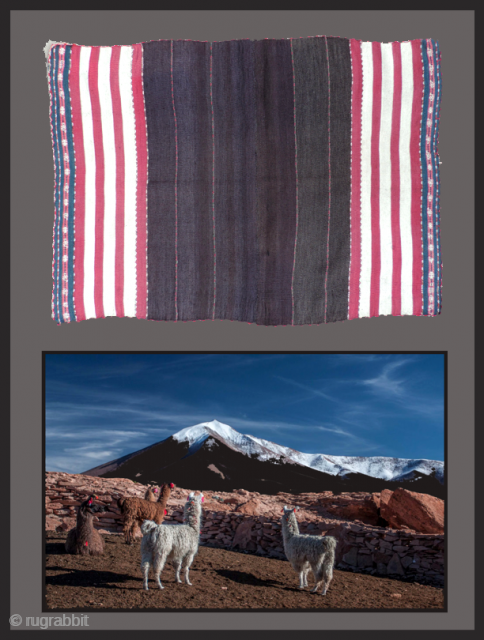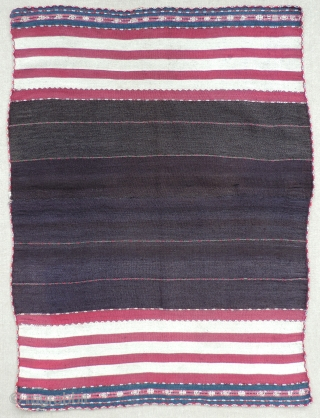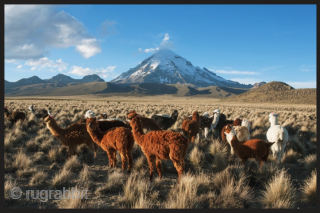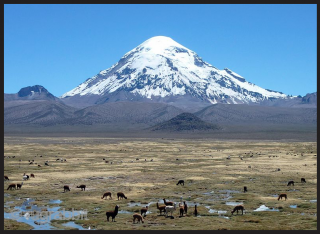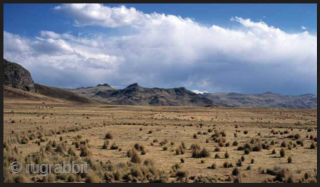Back
Aymara Indians. To live this high and weave this beautifully is truly remarkable! 12,500 ft. above sea level is the base elevation of the Altiplano region of Bolivia. This makes it the equal of the Tibetan plateau in altitude and one of two of the largest, highest habitation zones on earth. At approximately 600 x 80 miles it is a vast rugged basin bordered on the East and West by snow capped Andean ranges with peaks that rise to over 21,000 feet above sea level. Pastoralists, living mainly by their herds since the first domestication of llamas and alpacas more than 4,500 years ago, the indigenous peoples of the Lake Titicaca Basin created impressive civilizations and were the ancestors to the famous Incan Culture of the late 15th and early 16th centuries. Their weaving tradition goes back over 2000 years in this region. Warp-faced weavings were their primary medium. Selectively breading their vast herds of llamas and alpacas for fine, long staple fiber over many centuries meant that the Aymara were able to produce two ply yarns that are the finest in the world. The Aymara textile seen here is a 19th century ceremonial garment called a 'ponchito' or small poncho. It was draped over a larger poncho as a sign of distinction and honor and was worn by an elder of the community in important rituals and ceremonies meant to gain the favor of the ancestors in maintaining the health and prosperity of the herds and their families. Carefully stored inside their rustic stone houses or compounds by one family and passed down for generations, these textiles are quite rare when found in such good condition. Aymara textiles were never commercial commodities, but made strictly for personal use within the family. i have a number of excellent Aymara textiles collected over the years some of which can be seen on my Rugrabbit pages. Additional information on this textile or others as well as images are available upon request. Size: 28 x 37 inches.
price:
INQUIRE: jameswblackmon@gmail.com
- Home
- Antique Rugs by Region
- Category
- Profiles
- Post Items Free
- Albums
- Benaki Museum of Islamic Art
- Budapest: Ottoman Carpets
- Gulbenkian Museum
- Islamic Carpets. Brooklyn
- Islamic Textiles. Brooklyn
- Konya Museum: Rugs
- MKG, Hamburg
- MMA: Caucasian Carpets
- MMA: Mamluk Carpets
- MMA: Mughal Indian Carpets
- MMA: Ottoman Carpets
- MMA: Safavid Persian Carpets
- MMA: Turkmen Rugs
- McCoy Jones Kilims
- Ottoman textiles. Met
- Philadelphia Museum
- Rugs and Carpets: Berlin
- Seljuqs at the Met
- TIEM, Istanbul: Carpets
- V&A: Classical Carpets
- Vakiflar Carpets: Istanbul
- Baluch Rugs: Indianapolis
- Gallery Exhibitions
- Jaf an Exhibition
- Alberto Levi Gallery
- Andean Textile
- Christie's London: 2016
- Francesca Galloway
- HALI at 40
- ICOC Washington, DC 2018
- Jajims of the Shahsavan
- London Islamic Week April, 2018
- Mongolian Felts
- Navajo Rugs: JB Moore
- Persian Piled Weavings
- SF Tribal & Textile Art Show 2020
- SF Tribal 2019
- Sotheby's: C. Alexander
- Turkish Prayer Rugs
- Turkmen Main Carpets ICOC 2007








